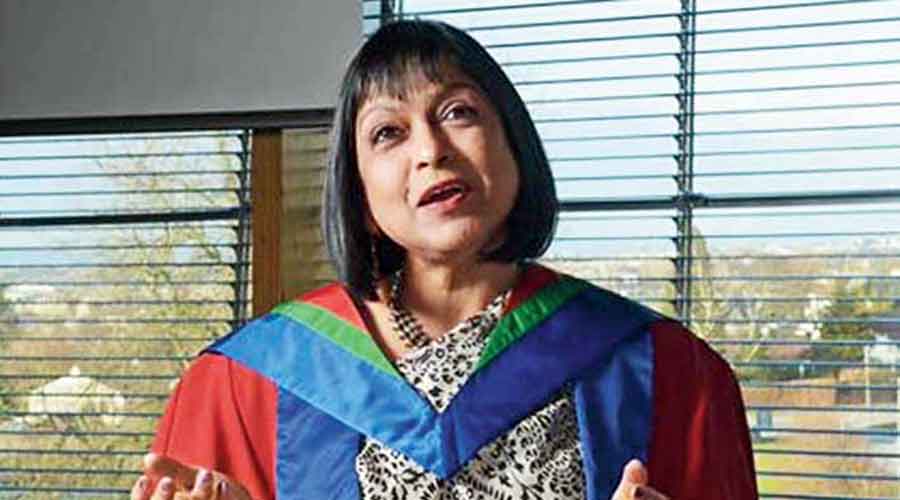First, huge congratulations on this wonderful achievement, Bashabidi. How did you come to know about your name featuring in the Queen’s New Year’s honours list? What were your first reactions?
In November last year, when I had gone to Calcutta to bring my father back with me to Edinburgh, I received a letter through email bearing the Royal Coat of Arms, from the Ceremonial Officer at the Cabinet Office, addressed to ‘Bashabi Fraser CBE’ (Commander of the Order of the British Empire). I was advised not to share this news with family or friends till the New Year Honours List was published on December 31.
I was astounded. I had to look up the Internet to remind myself what CBE stood for. I realised it was ‘the highest ranking Order of the British Empire’ and my first question to myself was, ‘have they made a mistake’? It was very difficult as I felt all bottled up and nervous as I couldn’t share the news with anyone and I couldn’t sleep through the nights. But slowly, I felt a glow of deep gratitude welling up inside me for this national recognition. I was truly humbled.
How has your family reacted to this honour... given that everyone in your family is a distinguished academician? What was the reaction of your nonagenarian father?
When I told my father, it was as if the sun had entered our room in winter! He said, ‘Your mother would have been so happy’. Then he asked, ‘So you will be meeting the Queen?’ I said, ‘I hope so.’ He added with a twinkle in his eye, ‘I met the Queen in London in 1961.’ My father was a Commonwealth Scholar at the London School of Economics. My husband Neil and daughter Rupsha were on cloud nine. Rupsha immediately put the news up on her Facebook page, but she and my son-in-law, Christoph, were sad that they couldn’t celebrate with me by opening a bottle of champagne as the lockdown continued.

Fraser with her father in front of the Spanish Steps in Rome during a cruise in 2019 which was his special 90th birthday gift
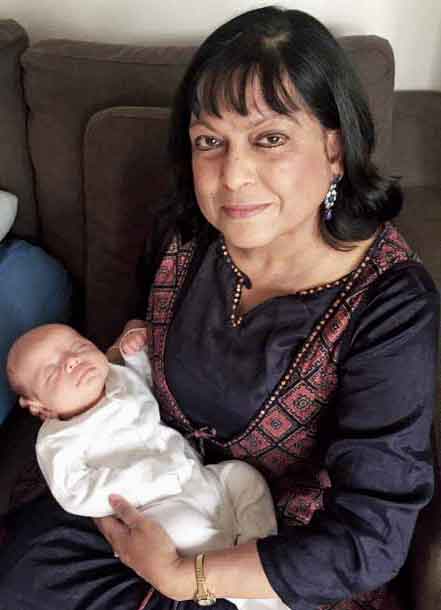
With her mother in London at the age of seven

With her mother in London at the age of seven

Bashabi (centre) with friends during her schooldays at St Helen’s Convent in North Bengal
You came to the UK as a child, with your academic parents, went back to India, came back to the UK for higher studies, found your love and life partner.... How did your remarkable story of resilience culminate in one of the highest honours of the land?
My father, Bimalendu Bhattacharya, was India’s first Commonwealth Scholar in the UK and my mother, Anima, won a scholarship at the London School of Economics (LSE). It was in London that I started writing poetry for my parents’ friend, Julian Dakin, the British Council Officer. Julian brought me books and we read them together, especially poetry. Unbeknown to my parents, Julian entered my poems for the Commonwealth Scholar Award and I won their first prize that year, though I was no Commonwealth Scholar. My father has treasured the journal with those poems which were published with my bad childish spelling, where I rhyme ‘daizy’ with ‘laizy’. Most embarrassing.
Julian remained a life-long friend of our family. After we returned to India, Julian, with his new bride, Carmen, came to Calcutta as the director of the Institute of English, which British Council had helped set up. Years later, when I was studying English Honours at Lady Brabourne College in Calcutta, Julian died very suddenly of a heart attack, as he was walking his bike across the Meadows to Edinburgh University where he was teaching at that time. It was a great loss for our family.
Though my parents were offered tutoring positions at the LSE, they declined as they wanted to return to India to serve their country. They chose to join a new university where they opened the first department of geography and applied geography in India. This was North Bengal University, in the foothills of the Darjeeling Himalayas with its sal forests and flanked by the Lachka river. There were no roads, electricity or running water. My parents were pioneers in the true sense and I think their spirit of adventure, idealism and dedication to education have stayed with me. The freedom we enjoyed on the university campus sustained us. I took my poetry notebook to the sal forest to write. My parents and their colleagues were liberal humanists, imbued with Tagore’s rootedness and internationalism and have been a great influence on me. However, though I continued to write poetry, I kept it to myself as writing poetry was not quite cool then.
I chose to come to Edinburgh University’s Department of Applied Linguistics for part of my PhD programme because it was Julian’s old department and I stayed with his widow, Carmen, and her partner, Michael. A fellow guest at Carmen’s, Erio Ziglio introduced me to his PhD supervisor, Neil. It was at Edinburgh University that my supervisor, Elizabeth Black, and a tutor, Mimo Caenepeel, who, with their unembarrassed love of poetry, made me feel comfortable about acknowledging poetry as my first love.
After I moved to Edinburgh after our wedding that his close friend, the poet, critic and historian, Angus Calder, insisted I publish a collection of poetry and the intrepid Sally Evans and Ian King of Diehard Publishers decided to publish Life (1997). In fact, you Debanjan, published a warm review of the book in a leading English daily and the British Council organised a public reading of my poetry. That was a significant milestone in my journey as a poet.

Bashabi and husband Neil (left) with Ruskin Bond at his Ivy Cottage in Mussoorie
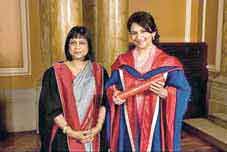
Bashabi with Sharmila Tagore in 2012 when she was awarded an honorary doctorate with Fraser doing the laureation

Bashabi reading on invitation at Shoi in Calcutta with Nabaneeta Dev Sen (right) and Bani Basu (left)
You are a distinguished poet, an essayist, an academic, a dancer, have held together your families in two continents, and as Debnita (Debanjan’s wife) and I know only too well from when we were research students in the UK, you are an amazing cook... Tell us how you manage being this dashabhuja Durga-like icon in real life?
I still have so much to write, that I don’t feel I have distinguished myself at all. I don’t feel like Durga, whose symbolism I hugely admire as a woman. My poetry has had to fill the interstices of my various commitments. I carry a notebook with me everywhere, just as I had done to the North Bengal forests as a girl.
When I moved to Scotland, I carried India with me, just as I had carried England back to India as a girl. The two nations have never left me and I guess that is why I find myself explaining one to the other and even catch myself defending one nation to the other.
I love the rhythm and spectacle of dance and have taught Kathak and been a choreographer and director of various classical, Rabindra Nritya and folk dance productions in Scotland. It was a way to share the cultural riches of India with the host population here and keep the flame of Indianness alive among subsequent generations of Scottish Indians in Scotland. Dance is also an interpretative tool, and as the rendering of Ganga to Tay in dance form by Rhythmosaic, with the support from British Council as UK India Year of Culture, proved, can transcend genres as well as national boundaries.
My grandmother (thakuma) and mother and all my aunts were wonderful cooks and kept an open house. I wanted to keep their tradition alive in my Scottish home, and this would not have been possible without Neil’s willingness to maintain a welcome table and being a marvellous under-chef. I find myself blending transnational flavours in my dishes. Food is also a wonderful way of sharing Indian culture and creating new connections by fusing flavours.
My work keeps taking Neil and I back to India. A recent ICCR International Fellowship meant I could spend half the year in India researching for my critical biography on Rabindranath Tagore. And Rabindranath has been at the root of sustaining my spirit as I continue to live between two worlds.
You have been an ardent advocate of UK-India connections. Tell us about some of your initiatives, in the domains of both education and culture, tangible and intangible heritage.
The long-shared history of India and Scotland has been something I have found fascinating. And English — the lingua franca in India and one of her two official languages — has strengthened this link in all my work.
As an academic, as I taught English literature at British universities, I soon found myself reading and analysing classics and modern texts from my viewpoint of being a postcolonial scholar and transnational citizen and incorporating work from the sub-continent and other ‘peripheries’ into the curriculum. In Scotland, first as a student and now as a citizen, I have come across people at receptions and gatherings eagerly asking me where I was from. My answer, ‘India’, was a trigger for them to tell me about their own ancestral links to India — a grandfather in the Indian army, a great uncle who was in the Indian Civil Services, a father who was tea garden manager in Assam…. And that is how I started interviewing Scots in India and have published several articles on the subject and books which document the links.
But the Scottish connection started long ago for me as I have said in my ‘Introduction’ to From the Ganga to the Tay. One of them was through Arthur Geddes, the geographer son of the Scottish polymath, Patrick Geddes, who spent two years teaching in Santiniketan and whom my parents met in London and were impressed by his perfect Bengali. When I came to Edinburgh as a post-graduate fellow, our friend, Carmen, introduced me to Arthur’s widow, Jeannie Geddes. The link was renewed with Murdo Macdonald, a Geddes specialist at Edinburgh University, directing me to the letters held at the National Library of Scotland between Tagore and Geddes. So I had to find the other side of the correspondence at Rabindra Bhavana with the help of the then adhyaksha, the late Swapan Majumdar. My former professor and mentor, Kitty Scoular Datta (another Scot) told me I should edit and introduce the correspondence, and so I did. It has come out in three revised editions (2002, 2004, 2005, with the fourth edition due in spring 2021, entitled, A Meeting of Two Minds: The Tagore-Geddes Letters).
I have also felt the need to explain the Partition of India, particularly the one on the eastern border, to a British and international audience and this is why I edited and introduced Bengal Partition Stories: An Unclosed Chapter, which I wrote with a British Academy Research Grant. A UK India Education Research Initiatives (UKIERI) grant enabled me to reaffirm the links with an academic exchange between Edinburgh Napier University, Visva-Bharati and Calcutta University. The outcome has been two books which I co-edited with Tapati Mukherjee and Amrit Sen — Scottish Orientalism and the Bengal Renaissance (2017) and A Confluence of Minds: The Rabindranath Tagore and Patrick Geddes Reader on Education and Environment (2017).
And amidst all this, Rabindranath has been the fortress of my faith in humanity and society. So when the 150th birth anniversary of Tagore was being celebrated in India and globally, I co-founded the Scottish Centre of Tagore Studies (ScoTs) at Edinburgh Napier University, which is an academic and cultural centre for collaborations with Indian and international institutions and with scholars, researchers, artists and writers who share and take forward the ideas and vision of Tagore and his circle.
I feel that your journey as a poet has this hallmark of your own complex layered identity and the multiple cultures that you inhabit with ease. Your epic poem, From the Ganga to the Tay, symbolises this.Tell us how your multiple identities have informed your poetry in particular...
When my daughter was a young teenager, she told me that when anyone asked her where she was from, she said her father was Scottish and her mother was from India. I think her answer fits my own sense of identity perfectly. It is true that I owe my first poetic expressions to my London experience. On our return to India, England stayed with me and I am truly grateful to my parents for sending me to St Helen’s Convent where the way of life seemed to flow seamlessly from my earlier British experience. My north Bengal upbringing rooted me, with the stimulating beauty of forests, tea gardens and mountain streams and basically two seasons — winter and the rains, making the foothills salubrious. Growing up against the backdrop of the Himalayas was humbling. Our life on the university campus was punctuated by scholarly seminars, Rabindrasangeet performances on moonlit nights in the sal forest and all-night classical concerts from which we walked back at dawn with the Bhairavi raga ringing in our ears. It was idyllic, intellectually stimulating, culturally rich and safe. My parents had a wonderful library at home, where I read Bengali literature when I came home for the three months’ winter holidays from my school in the hills and again during vacations when I was a student at Lady Brabourne College and later Jadavpur University, studying English. So the dual influence of English and Bengali were like a dotara (the two-stringed instrument used by Bauls) in my consciousness.
Coming to live in Scotland was like a homecoming — this time to what became my second home. So, now there was another strand added to my consciousness — the Scottish with the English. But first of all, I’m an Indian as well as a Bengali, born in West Bengal, but also with ancestral roots in what is now Bangladesh. I have always felt an affinity with my English beginnings and am an Indo-Scot with loyalties spread across cultures and continents. And this is what my modern epic poem, From the Ganga to The Tay embodies, a conversation between two timeless life-giving rivers who have a shared history, who have multiple concerns — environmental and cultural, political and economic, while being both local and global. It is a transcultural reality that moves beyond borders and boundaries.
Both my countries creep into my creative reflections as evident in the titles of my books — With Best wishes from Edinburgh (published in India, 2001), Tartan & Turban (2004), From the Ganga to the Tay (2009), Ragas & Reels (2012), Scots Beneath the Banyan Tree: Stories from Bengal (2012), The Homing Bird (2017) and even in my recent edited anthology, Thali Katori: An Anthology of Scottish and South Asian Poetry (co-edited with Alan Riach, 2017).
Rabindranath Tagore and Patrick Geddes’s friendship and intellectual collaboration across disciplines is symbolic of the long conversation between civilisations that has happened between UK and India. What is your take on this history and its future?
The friendship between Tagore and Geddes was possible because of the meeting of two great minds, as they both saw the need for interdisciplinary studies, collaboration and cooperation, believing that nation-building could only be achieved through education, intellectual exchange across nation-state boundaries, interchange between the rural and urban, rural reconstruction and urban regeneration. This is what drew me to them, as they signify a dialogue between equals who had immense respect for each other. Geddes was a friend of Mahatma Gandhi and Sir Jagadish Chandra Bose, staying in close correspondence with them and writing the biography of the pioneer in biology. I can visualise a future in their mode of interchange, which I have seen carried forward by many of my friends in Scotland today, friends who are South Asianist academics, directors and curators of museums and galleries, librarians and others who have familial ties with India and Indians who have made Scotland their home.
Having seen the repercussions of Partition in economic, cultural and psychological fissures, I am wary of the wounds that Brexit might inflict. But what has happened across the Atlantic shows that change is possible. Britain is European and Britain has long trade links with India, so I hope we can build on old foundations as we embrace diversity and not look for differences. But I am a poet and, hence, a romantic and like Rabindranath and Geddes, I have faith in human resilience and I hope goodwill will prevail.
You’ve been a student from India in the UK and now one of the leading lights in culture studies in one of UK’s foremost universities. What advice do you have for young students from India who plan to study in the UK, particularly young women who aspire for international education and careers?
I would tell Indian students, especially women, to have faith in their intellectual prowess and not fight shy of questioning what is handed down to them as the ‘truth’, but to know that they can challenge all power constructs, build their own arguments as long as they can find the evidence to support their perspective and conclusion. They do not need to sign forms in the UK as someone’s daughter, wife or mother. They do not have to state their caste or religion. They can just be themselves, women in their own right.
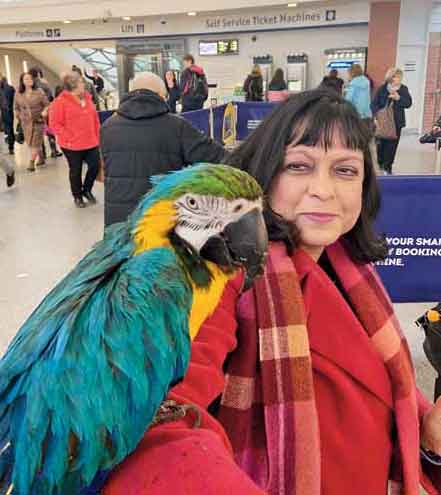
Bashabi with a colourful feathered friend in her current home town Edinburgh
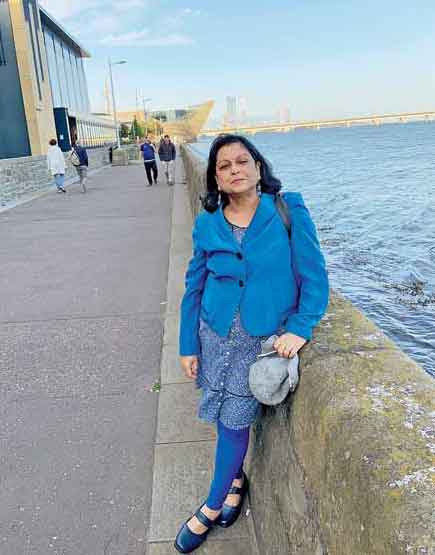
Fraser in Dundee by the River Tay, which has been her metaphor for Scottish culture

Fraser and husband Neil with Debanjan Chakrabarti and his wife Debnita at a British Council reception in Calcutta
What impact has Black Lives Matter had on you as person, a poet and as someone who has an incredibly inspirational mixed race/nationalities family across generations?
A huge impact. I have many friends, colleagues and students who are British Black and I have witnessed and felt deeply the institutional racism they suffer and the indignities inflicted on them in their everyday existence. It has given me great pain to see what the colour of your skin can do to impede your every endeavour. I have felt the same pain at the continuing practice of the caste system in India and shudder to think what the accident of birth can do to blight your whole life and prospects.
During the pandemic, the inequality and poverty of Black and ethnic minorities have shown how disproportionately they have suffered from infections and deaths. The protestors were not just Black and Asian, but were joined by their white compatriots who asserted Black Lives DO Matter and we were not going to let police brutality and discrimination continue, not in anyone’s name. As a member of the executive committee of Scottish PEN, we are supporting the Amplify Black Voices Movement, promoting books by Black writers.
Also, as a Royal Literary Fund Fellow, I am on the editorial board of WritersMosaic, which is a platform for writers of colour in Britain with a journal and an archive to document voices from the margins of literary Britain.
Your CBE citation states that you are being honoured for your “services to education, culture and Scottish integration”. Tell us a little about your work in “Scottish integration”...
When I came to live in Scotland, I decided that alongside my academic career, I should help in the community. This is when I encountered the racism faced by Black and Asian communities. I realised that what I had to do in my small way was share our culture and heritage with the host community to create understanding and respect. One method I used was through dance classes [at the Indian Music and Dance Collective, Dance for All Studios and with Dance Base]. I instilled a love of and pride in our ragas and talas in the second generation, who have become ambassadors for their culture. Our dance shows and creative fusion programmes had a large appreciative Scottish audience. I curated Indian film festivals at the FilmHouse, supported artists, writers and researchers from India and helped to organise concerts, readings and talks for them, such as Swapan Gupta, the Rabindrasangeet vocalist, Nandikar, the theatre group, and Dancers Guild. The last was done through the Scottish Centre of Tagore Studies (ScoTs), which has been a prominent platform for holding national and international conferences to facilitate an exchange on Indo-Scottish themes.
This many-layered approach to addressing popular culture on the one hand and an academic audience on the other, has, I hope, contributed to integration in Scotland through a sharing and appreciation of literature, art and culture from the sub-continent.
- Debanjan Chakrabarti is director, British Council, East and Northeast India, and a long-time friend of Professors Bashabi and Neil Fraser
